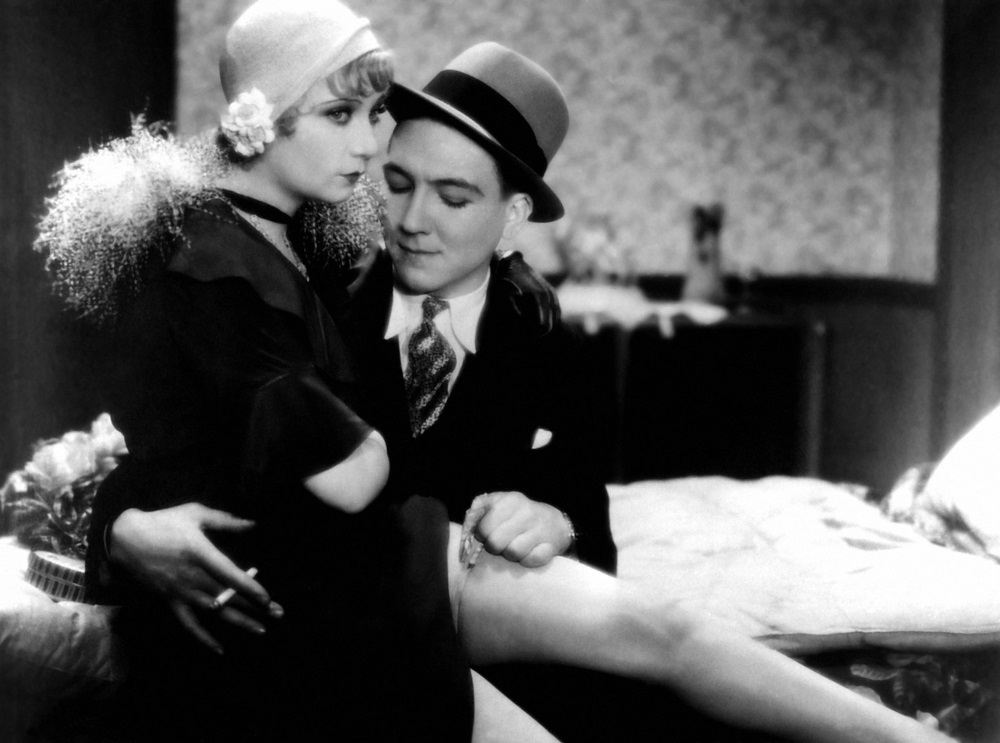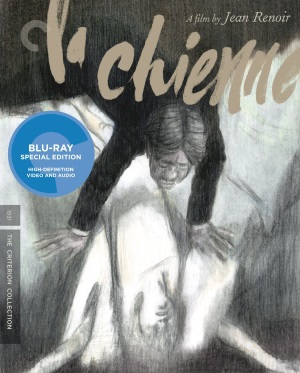 La Chienne (Criterion, Blu-ray, DVD), the second sound film by Jean Renoir, is arguably his first masterpiece and it shows Renoir already using sound both subtly and creatively back in 1931.
La Chienne (Criterion, Blu-ray, DVD), the second sound film by Jean Renoir, is arguably his first masterpiece and it shows Renoir already using sound both subtly and creatively back in 1931.
Adapted from a novel by Georges de La Fouchardière, it stars Michel Simon as Maurice, a henpecked cashier and weekend painter who falls for a bruised prostitute named Lulu (Janie Marèse) and, passing himself off as a profession artist, supports her in exchange for her favors. Meanwhile she’s hopelessly in love with her abusive pimp Dédé (Georges Flamant), who forces her to keep up the arrangement as long as Maurice keeps paying out. When Dédé’s gambling debts get out of hand, they start passing of Maurice’s paintings as hers, creating a minor sensation in the art world of Paris. The situation is doomed from the beginning—Maurice has been embezzling to sustain his lifestyle and Lulu stays with him only because Dédé demands it—and the truth comes out with fatal consequences.
Renoir frames the film with a Punch and Judy-like puppet show introduction, which proclaims the film has “no moral message,” and shoots much of his film on location and uses long takes and fluid camerawork and a rich sound design, which brings the film into the physical world. It gives the film a richness of character and an aesthetic approach he would continue to explore through the 1930s. This is as much human comedy as tragedy as only Renoir can balance it. It was remade by Fritz Lang in Hollywood as the film noir Scarlet Street (1945), which cast a darker shadow over it all. Renoir’s more sympathetic approach offers humanism with an edge of irony to it, fitting for a story with such willfully oblivious characters.
The American disc debut is mastered from a new 4K digital restoration from a fine-grain print made from the original negative. Also includes a new restoration of Renoir’s debut sound film On purge bébé (1931), also starring Michel Simon, plus an introduction to the film by Jean Renoir filmed in 1961 for a television showing and the 1967 television program Jean Renoir le patron, a 95-minute interview documentary directed by Jacques Rivette and featuring a conversation between Renoir and Simon, plus a fold-out insert with an essay by film scholar Ginette Vincendeau.
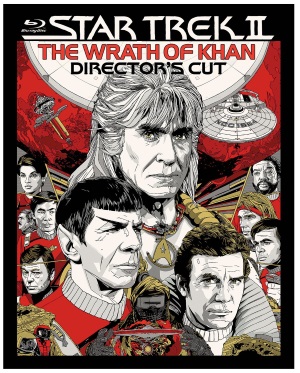 Star Trek II: The Wrath of Khan – Director’s Cut (Paramount, Blu-ray), still the best of the big screen Star Trek movies, features Ricardo Montalban reprising his role from the original series TV episode “The Space Seed,” but now the genetically perfect human has become a man obsessed with revenge against Captain Kirk. This a veritable swashbuckler of a sci-fi adventure, as different as could be from the stately, stodgy first film. Director Nicholas Meyer brings a panache to the production and James Horner’s brassy score is jaunty and heroic, perhaps his best ever. Best of all, William Shatner, Leonard Nimoy, and DeForest Kelley seem to have both gotten in touch with their characters and relationships all over again—deftly flirting with the changes of age and gleefully falling into familiar clashes of logic versus emotion—while Shatner’s Kirk springs into action with the wiles of an old fox teaching the young cubs the real rules of the wild. And of course there is the still impressive sight of wild-maned and bare-chested Montalban looking more buff and cut in his sixties than most of the young stars on screen.
Star Trek II: The Wrath of Khan – Director’s Cut (Paramount, Blu-ray), still the best of the big screen Star Trek movies, features Ricardo Montalban reprising his role from the original series TV episode “The Space Seed,” but now the genetically perfect human has become a man obsessed with revenge against Captain Kirk. This a veritable swashbuckler of a sci-fi adventure, as different as could be from the stately, stodgy first film. Director Nicholas Meyer brings a panache to the production and James Horner’s brassy score is jaunty and heroic, perhaps his best ever. Best of all, William Shatner, Leonard Nimoy, and DeForest Kelley seem to have both gotten in touch with their characters and relationships all over again—deftly flirting with the changes of age and gleefully falling into familiar clashes of logic versus emotion—while Shatner’s Kirk springs into action with the wiles of an old fox teaching the young cubs the real rules of the wild. And of course there is the still impressive sight of wild-maned and bare-chested Montalban looking more buff and cut in his sixties than most of the young stars on screen.
The Director’s Cut, which adds about four minutes, makes its Blu-ray debut in a slightly amended version (Meyer cut two redundant lines, just a couple of seconds from one shot) in a new 4K restoration along with the original theatrical cut plus the new 21-minute featurette “The Genesis Effect: Engineering The Wrath of Khan.” Carried over from previous DVD editions are commentary by Nicholas Meyer for the director’s cut (which also includes a text commentary option provided by Michael and Denise Okuda) and by Meyers with producer Manny Coto on the theatrical cut (which also includes the “Library Computer” graphic trivia interface, aka trivia track), plus the featurettes “The Captain’s Log,” “Designing Khan,” “Where No Man Has Gone Before: The Visual Effects of Star Trek II,” “James Horner: Composing Genesis,” vintage interviews, and other supplements.
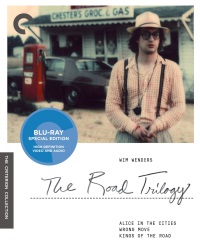 Wim Wenders: The Road Trilogy (Alice in the Cities / Wrong Move / Kings of the Road) (Criterion, Blu-ray, DVD) offers the disc debut of three defining early features by German filmmaker Wim Wenders, all starring Rudiger Volger on journeys across Germany. They double the number of Wenders movies released by Criterion and present his international breakthrough film (Alice) and his first unabashed masterpiece (Kings).
Wim Wenders: The Road Trilogy (Alice in the Cities / Wrong Move / Kings of the Road) (Criterion, Blu-ray, DVD) offers the disc debut of three defining early features by German filmmaker Wim Wenders, all starring Rudiger Volger on journeys across Germany. They double the number of Wenders movies released by Criterion and present his international breakthrough film (Alice) and his first unabashed masterpiece (Kings).
Alice in the Cities (1974), starring Volger as a photojournalist returning to Germany from a journey across America and young Yella Rottlander as a girl left in his care by her single mother (Lisa Kreuzer), is Wenders’ fourth feature and his international breakthrough. When her mother fails to show at their meeting place, he takes the girl on a road trip through the Ruhr region to find her grandparents. The black and white film is photographed by Robby Muller, who shoots all three films and captures the easy, meandering pace and observational style that defines the entire trilogy. Wrong Move (1975), inspired by Goethe novel and scripted by German novelist Peter Handke, is the most overtly literary of the three films (the characters tend to speak in quotations marks) and the most dour. Volger as an alienated, self-involved would-be writer who goes traveling to find something to write about and gathers a temporary group of lost and lonely souls around him (including Hanna Schygulla and Nastassja Kinski in her first screen role). Kings of the Road (1976) is one of Wenders’ masterpieces, a road movie epic starring Volger as a movie projector repairman who visits small town cinemas near the East German border and Hanns Zischler as an aimless child psychologist reeling from a recent divorce who becomes his traveling companion. It is almost three hours long and episodic, with a gentle serenity and contemplative tone interspersed with the dramas of people they meet along the way. While these are not sequels, they are united by the theme of searching for identity in 1970s Germany (where the legacy of the Nazi past is suppressed but echoes through films), the road movie structure, and the casting of Volger in the lead, and they established Wenders as a major filmmaker of the New German Cinema.
All three films have been newly restored and feature a new subtitle translation by Wenders. On Blu-ray and DVD from Criterion with filmmaker commentary on each film, new interviews with Wenders and actors Rudiger Volger, Hanns Zischler, and Lisa Kreuzer, Wenders’ short films Same Player Shoots Again (1967) and Silver City Revisited (1968), a restoration featurette, outtakes, and behind-the-scenes footage, plus a booklet with new essays.
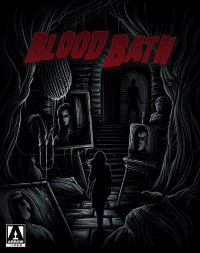 Blood Bath (Arrow, Blu-ray+DVD) lavishes the special edition treatment on a Roger Corman production famed for its multiple versions. Corman was adept at recycling and this one recycles a film he funded in Yugoslavia, a murder mystery called Operation Titian (1963) that revolved around art theft. Corman found the film unreleasble in the U.S. and handed it to Jack Hill, who had been faithfully jumping in to offer second-unit footage and, when necessary, “finish” troubled films (such as Francis Coppola’s Dementia 13). He matched the shadowy footage of cobblestone streets and old world alleys and buildings of Belgrade with a drama set in the world of Beat poets and tortured artists in the coffee house culture of Venice, CA in the mid-sixties. His film plays like a serious version of Corman’s cult black comedy Bucket of Blood, with William Campbell as the tormented creator whose paintings meld art and murder. A cast of beauties becomes victims and terrorized targets, including Lori Saunders (often seen in a bikini), Marissa Mathes (whose nude modeling is carefully concealed by targeted angles) and Sandra Knight. The victims are dropped into a vat of wax (a la House of Wax) in an underground dungeon right out of Corman’s Poe films, which somehow found its way to California.
Blood Bath (Arrow, Blu-ray+DVD) lavishes the special edition treatment on a Roger Corman production famed for its multiple versions. Corman was adept at recycling and this one recycles a film he funded in Yugoslavia, a murder mystery called Operation Titian (1963) that revolved around art theft. Corman found the film unreleasble in the U.S. and handed it to Jack Hill, who had been faithfully jumping in to offer second-unit footage and, when necessary, “finish” troubled films (such as Francis Coppola’s Dementia 13). He matched the shadowy footage of cobblestone streets and old world alleys and buildings of Belgrade with a drama set in the world of Beat poets and tortured artists in the coffee house culture of Venice, CA in the mid-sixties. His film plays like a serious version of Corman’s cult black comedy Bucket of Blood, with William Campbell as the tormented creator whose paintings meld art and murder. A cast of beauties becomes victims and terrorized targets, including Lori Saunders (often seen in a bikini), Marissa Mathes (whose nude modeling is carefully concealed by targeted angles) and Sandra Knight. The victims are dropped into a vat of wax (a la House of Wax) in an underground dungeon right out of Corman’s Poe films, which somehow found its way to California.
The vampire is courtesy of Stephanie Rothman, who shares directing and writing credit with Jack Hill, even though they essentially worked at cross purposes. Corman, dissatisfied with Hill’s version, handed the production over to Rothman, who rewrote the film to turn the artist into a vampire (played by an actor without the slightest resemblance to Campbell) and shot new footage to shoehorn this bizarre twist into the existing story. Rothman’s vampire is a hammy creation that doesn’t charm or terrify anyone, least of all the viewer. Hill’s location footage, however, is really quite handsome, giving a gothic atmosphere to Venice after dark. He has a great time with the coffee house beat culture, where Hill favorite Sid Haig (as Abdul the Arab) struggles to fit into the hipster group of insiders, and turns a flashback (featuring Corman himself as a long-dead painter) into a psychedelic nightmare. And watch for an inspired lift from Hitchcock’s Strangers on a Train, where he shoots a carousel horse as if a demon charging the camera. The scars of the production history are readily apparent in the film’s detours into incoherence, but Hill’s scenes are interesting enough to wish that his version of the film still existed. Until then, this is what we have.
The film exists in four (that’s FOUR!) different versions and this set features all four: the original Operation Titian produced in Yugoslavia (reconstructed for this edition), the recut Portrait in Terror, Blood Bath featuring new scenes shot and edited by first Jack Hill and then Stephanie Rothman, and finally Track of the Vampire, which was the version prepared for TV, all mastered in HD for this unique box set. The three alternate cuts were mastered in 2K from original film materials, and the set include new and archival interviews, a new visual essay from Tim Lucas on the multiple versions, outtakes, and other supplements, plus a booklet.
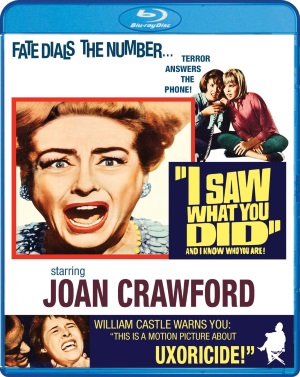 Filmmaker and savvy promoter William Castle made his low budget thrillers and horror film into hits with a steady stream of gimmicks through the late 1950s and 1960s. His 1965 I Saw What You Did (Shout! Factory, Blu-ray), a lightweight thriller about two schoolgirls and a prank phone call that backfires with a vengeance, is far less gimmick laden (“The telephone was the star” of the film, he wrote in his autobiography). When the girls whisper “I saw what you did, and I know who you are” to a perfect stranger, little do they know he has just murdered his wife and is now out to silence any witnesses. An aging John Ireland plays the homicidal husband and (despite her prominent placement in the artwork) Joan Crawford has little more than a cameo as an amorous neighbor turned blackmailer. Castle leaves the spook show gimmicks and high concept twists out of this thriller, which prefigures the teen scream genre by decades, but proves to be little better than competent as a suspense director. He misses all opportunities for psychological horror, preferring shocks and startles over genuine suspense, and he ignores the voyeuristic possibilities and the sexual perversity of the middle aged killer stalked by his young, sexually curious target. He’s more at home as a showman than a dime store Hitchcock, but the film does exhibit a little Castle flair, such as an inventive prologue framed in a pair of opening and closing eyes.
Filmmaker and savvy promoter William Castle made his low budget thrillers and horror film into hits with a steady stream of gimmicks through the late 1950s and 1960s. His 1965 I Saw What You Did (Shout! Factory, Blu-ray), a lightweight thriller about two schoolgirls and a prank phone call that backfires with a vengeance, is far less gimmick laden (“The telephone was the star” of the film, he wrote in his autobiography). When the girls whisper “I saw what you did, and I know who you are” to a perfect stranger, little do they know he has just murdered his wife and is now out to silence any witnesses. An aging John Ireland plays the homicidal husband and (despite her prominent placement in the artwork) Joan Crawford has little more than a cameo as an amorous neighbor turned blackmailer. Castle leaves the spook show gimmicks and high concept twists out of this thriller, which prefigures the teen scream genre by decades, but proves to be little better than competent as a suspense director. He misses all opportunities for psychological horror, preferring shocks and startles over genuine suspense, and he ignores the voyeuristic possibilities and the sexual perversity of the middle aged killer stalked by his young, sexually curious target. He’s more at home as a showman than a dime store Hitchcock, but the film does exhibit a little Castle flair, such as an inventive prologue framed in a pair of opening and closing eyes.
It makes its Blu-ray debut from a new HD transfer and includes two archival trailer and a photo gallery.

